Western North Pacific anomalous anticyclone (WNPAC, or referred to as Philippine Sea anomalous anticyclone) is the most important anomalous circulation pattern connecting El Niño and East Asian-western North Pacific monsoon. WNPAC persists from the El Niño mature winter to the following summer and thus is one of the most long-lasting anomalous circulation patterns over the entire tropical climate system. A new mechanism was proposed by CAS Institute of Atmospheric Physics(IAP) and University of Hawaii to explain the maintenance of the WNPAC, which was named as "anomalous moist enthalpy advection mechanism". Furthermore, the team also used the mechanism to explain why the WNPAC forms in the late fall of El Niño developing phase.

Schematic of the anomalous moist enthalpy advection mechanism. Warm SSTAs in the equatorial CEP (red line) enhance local convection (green shading) and thus stimulate cyclonic anomalies to the northwest (black solid line). The northerly component of the western flank of the cyclonic anomalies advects off-equatorial dry (low moist enthalpy) air into the tropical WNP and thus suppresses convection there (orange shading). The suppressed convection further stimulates the WNPAC (black dashed line) to the northwest. [Image by (Wu et al. 2017a)]
Since 2000s, it has been widely accepted that the WNPAC is maintained by the local air-sea interaction via wind-evaporation-Sea Surface Temperature (SST) feedback over the tropical WNP during El Niño mature winter and following spring. However, some recent studies found that the WNPAC can be simulated by an Atmospheric General Circulation Model (AGCM), driven by El Niño-related warm SST anomalies in the central-eastern Pacific plus climatological SST in other ocean areas, indicating that the WNPAC can be maintained by an atmospheric bridge from equatorial central-eastern Pacific without the help of local air-sea interactions in the WNP. The contradiction between the leading theory and the AGCM experiments suggests that a new theory is needed to be developed for the maintenance of the WNPAC.
"The ‘anomalous moist enthalpy advection mechanism’ proposed in our study works through pure atmospheric dynamic and thermodynamic processes and does not rely on the local air-sea interactions in the WNP." Says Dr. WU Bo, the lead author of the study published in Journal of Climate. According to the study, idealized numerical experiments further suggested that the contribution of the new mechanism to the WNPAC is larger than that of the local air-sea interactions.
"Furthermore, the new mechanism can reasonably explain the formation timing of the WNPAC, which cannot be explained by the previous theories." Says Prof. ZHOU Tianjun, a co-author of the study also from IAP.
References:
Wu, B., T. Zhou, T. Li, 2017a: Atmospheric dynamic and thermodynamic processes driving the western North Pacific anomalous anticyclone during El Niño. Part I: Maintenance mechanisms, Journal of Climate, 30, 9621-9635. http://journals.ametsoc.org/doi/abs/10.1175/JCLI-D-16-0489.1
Wu, B., T. Zhou, T. Li, 2017b: Atmospheric dynamic and thermodynamic processes driving the western North Pacific anomalous anticyclone during El Niño. Part II: Formation processes, Journal of Climate, 30, 9637-9650. http://journals.ametsoc.org/doi/abs/10.1175/JCLI-D-16-0495.1
Media Contact: Ms. LIN Zheng, jennylin@mail.iap.ac.cn
